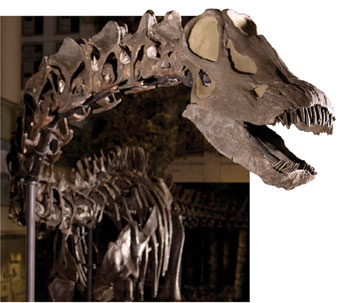 Winter 2007
Winter 2007|
Diplodocus carnegii
How does it feel to be back? I’d like to send a shout out to the folks at Phil Fraley Productions. They thought they had their hands full with “Sue,” the Field Museum’s much ballyhooed T.rex. Ha! They had no idea what they were in for when they accepted the challenge from Carnegie Museum of Natural History. We Carnegie dinosaurs—one of the most esteemed and largest collections of real dinosaurs in the world, I might add—were quite a handful. It’s taken Fraley and his team, joined by the museum staff here, nearly two years to make us look like new again. Fraley and company are still hard at work on Tyrannosaurus rex. Not a very pleasant fellow, that cranky carnivore. Now we have our own spaces, in the familiar environments of our own time periods, situated with our own kind. My thanks to Carnegie Museum of Natural History for being the first museum in the world to finally get it right. But let’s remember: It wasn’t Sheep Creek, Wyoming, when my friends and I inhabited our part of the world. Just before the end of the Jurassic Period, Earth’s one large land mass, the supercontinent called Pangaea, had sepa-rated into two smaller masses, called Laurasia and Gondwana. I resided in Laurasia, which included most of today’s Northern Hemisphere—North America, Europe, and Asia. I hear you have seven continents today. Cool! That little Scotsman sure was proud of me back in the early 1900s, wasn’t he? And he couldn’t say no to anyone. For instance, when the king of England wanted one of me for his country, Carnegie asked his museum team here in Pittsburgh to get busy creating a cast of my bones that he could send across the pond, to London. He’d end up doing the same for museums in Berlin, Paris, Vienna, St. Petersburg, Bologna, La Plata (Argentina), and Mexico City. Of course, there’s nothing like the real thing. Pittsburgh will always be home to me, the original Diplodocus carnegii, as well as the real, nearly complete skeletons of 14 other dinosaurs of all types. In the United States, only the Smithsonian and the American Museum of Natural History in New York have more. In fact, our tails counterbalanced our long necks, and made us a lot more nimble than any of you previously thought. Sure, I weighed 15 tons. But in my prime, I could really move—about as well as those little tusked, trunked mammals you have today. You call those things elephants, right? We dinosaurs just want to be remembered. Even the mean and nasty ones, like Allosaurus and T.rex. And, hopefully, you’ll all learn a thing or two about your own world in the process. I think that’s the whole point of Dinosaurs in Their Time, isn’t it? |
Walking with the Dinosaurs · Tales from the Supporting Cast · From Trophies to Treasures · The Popular Salon of the People: Then and Now · Director's Note · NewsWorthy · Now Showing · About Town: International Appeal · First Person: It takes a village to raise a dinosaur · Artistic License: Size Matters · Science & Nature: Bodies of Knowledge · Another Look: Neapolitan Presepio Celebrates
 |
Copyright © 2017 CARNEGIE Magazine. All rights reserved. |

 He roamed what’s now known as the American West 150 million years ago, one of the largest land animals to ever live. The world didn’t even know he existed, though, until 1899, when a dinosaur hunt commissioned by Pittsburgh industrialist Andrew Carnegie unearthed one of his bones in a rocky outcrop not far from Sheep Creek, Wyoming. There was a lot more of him where that came from, and he was soon christened Diplodocus carnegii after his wealthy benefactor. By the close of that same year, he would get a free, cross-country trip to Pittsburgh, one crate at a time. And it would take all of 130 crates to transport this 85-foot-long giant to the Steel City, where he would eventually be pieced back together for display, albeit in a pose not entirely comfortable or anatomically correct. He’s been the pride and joy of Carnegie Museum of Natural History ever since, even after he was no longer the only tall, good-looking dinosaur on the block. And now, after spending 10 months in New Jersey for a much-needed makeover, Diplodocus carnegii is back.
He roamed what’s now known as the American West 150 million years ago, one of the largest land animals to ever live. The world didn’t even know he existed, though, until 1899, when a dinosaur hunt commissioned by Pittsburgh industrialist Andrew Carnegie unearthed one of his bones in a rocky outcrop not far from Sheep Creek, Wyoming. There was a lot more of him where that came from, and he was soon christened Diplodocus carnegii after his wealthy benefactor. By the close of that same year, he would get a free, cross-country trip to Pittsburgh, one crate at a time. And it would take all of 130 crates to transport this 85-foot-long giant to the Steel City, where he would eventually be pieced back together for display, albeit in a pose not entirely comfortable or anatomically correct. He’s been the pride and joy of Carnegie Museum of Natural History ever since, even after he was no longer the only tall, good-looking dinosaur on the block. And now, after spending 10 months in New Jersey for a much-needed makeover, Diplodocus carnegii is back.